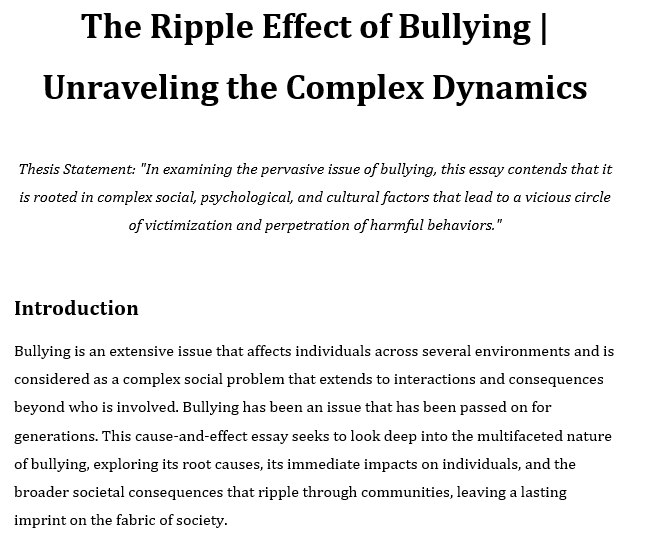The Ripple Effect of Bullying | Unraveling the Complex Dynamics
Thesis Statement: “In examining the pervasive issue of bullying, this essay contends that it is rooted in complex social, psychological, and cultural factors that lead to a vicious circle of victimization and perpetration of harmful behaviors.”
Introduction
Bullying is an extensive issue that affects individuals across several environments and is considered as a complex social problem that extends to interactions and consequences beyond who is involved. Bullying has been an issue that has been passed on for generations. This cause-and-effect essay seeks to look deep into the multifaceted nature of bullying, exploring its root causes, its immediate impacts on individuals, and the broader societal consequences that ripple through communities, leaving a lasting imprint on the fabric of society.
Cause 1 – Social and Psychological Factors
When it comes to bullying, social and psychological factors play an influential role in the behavior of an individual. Insecurity about the environment, issues in the family and a lack of optimism in role models are factors that lead to aggression in the individual behaviors. To curb the bullying incidents, it is imperative to look at the root causes.
Effect of Social and Psychological Factors
Victimization and Emotional Distress
The most impactful consequence of bullying is how individuals are victimized, the targets experienced heightened anxiety levels, depict signs of depression, and a feeling of helplessness. Such emotional toll can thrive in numerous ways that impact the academic performance, self-esteem and the overall mental health of the suffering individuals.
Perpetuation of Cycles of Violence
It may sound disturbing, but is highly likely that the individuals who are bullying may have been a victim of the same abuse. The violence circles around as these perpetrators seek power and control, when they are unable to get the desired power, they start projecting their insecurities on others. This kind of perpetuation creates a toxic cycle within communities, where aggression beats aggression, hindering the development of healthy social dynamics.
Cause 2 – Lack of Awareness and Education
The insufficient knowledge and awareness of bullying and its consequences lead to its prevalence. Most of the time, perpetrators and bystanders will not be able to fully understand how their actions would have long term effects. In today’s era, knowledge is power, the people today are very educated and have exposure to issues like bullying, its a common concern. Even if the children are unable to understand the signs of being a bully or being bullied, the parents should keep an eye on their child’s behavior to highlight red flags if any.
Effects of Lack of Awareness and Education
Normalization of Bullying Behaviors
Bullying is normalized in environments where there is lack of awareness or knowledge. Individuals may fail to understand the gravity of their actions and may discredit them as teasing, something really harmless. This normalization of behavior creates a culture where bullying is a normal act and hence the vicious circle continues. Bullying should not be taken lightly because it has long term effects on the mind and gravely affects the personality of the individual. The earlier this issue is addressed, the better it is.
Limited Intervention and Reporting
As a result of insufficient awareness, people are usually reluctant to intervene or report bullying. In such scenarios, bystanders and witnesses feel threatened by retaliation, they lack confidence to report the incident or are completely unaware of resources that are able to address bullying as an issue. When intervention is delayed or avoided, a culture of silence is built around bullying which allows it to go unchecked.
Cause 3 – Cyberbullying and Online Platforms
Advancement in technology has benefited the human kind in ways unimaginable, but it has also raised concerns regarding a new form of bullying: cyberbullying. The anonymity provided by online platforms is taken for granted and allows individuals to engage in harmful behaviors and get away with minimal or no consequences. Moreover, with the increased use of social media, cyberbullying has been feeding on the addiction of individuals to stay updated constantly regarding the present trends on social media.
Effects of Cyberbullying and Online Platforms
Amplification of Harm and Global Reach
Leaping physical boundaries, cyberbullying extends the reach and impacts of bullying, When hate messages, inappropriate images and rumors spread and they reach the global audience, the effects of online harassment are magnified. The fact that the individual gets to stay anonymous during such activities, makes them bold enough to engage in extreme forms of bullying. They take the anonymous feature to their benefit and feel like they get to bypass the hate crime only because it’s online.
Mental Health Consequences
The consequences of cyberbullying on mental health are profound. Victims may experience elevated levels of anxiety, depression, and a sense of isolation. Because online spaces are easily accessible, the emotional harm from cyberbullying can last a long time after the initial incident, causing lasting psychological effects.
Cause 4 – Societal Attitudes and Cultural Norms
Societal attitudes and cultural norms are key factors that shape up the perceptions of bullying. Sometimes, the promotion of stereotypes, a culture of being overly masculine, and a focus on competition create an environment where bullying is allowed or ignored.
Effects of Societal Attitudes and Cultural Norms
Marginalization and Stigmatization
Bullying usually happens to people who are different from what society thinks is normal. This includes those who are part of groups that often face discrimination, like the LGBTQ+ community, people from different races or ethnicities, or those with disabilities. This makes these already vulnerable groups feel even more left out and stigmatized, making societal divisions worse.
Impacts on Workplace Culture
Bullying is not limited to school life or children only. It is a fairly common issue in the professional world and a lot of adults suffer because of it. In workplaces, bullying can be severe enough to poison the organizational culture. Instances of workplace bullying create an atmosphere of fear, erode trust among colleagues, and hinder productivity. The negative workplace culture may contribute to high turnover rates, employee disengagement, and a decline in overall organizational effectiveness.
Conclusion
Bullying is a serious problem with many causes and effects. To solve it, we need to do many things like educating people, creating awareness, intervening when necessary, and changing how society thinks about bullying.
By understanding how everyone’s actions are connected and affect everyone, we can create places where bullying is not accepted. We can encourage kindness, respect, and include everyone. If we all work together, we can make communities better, where people can live without the negative impact of bullying, and where everyone is treated with kindness and understanding.
This is Izzah, a content writer and editor who creates SEO-friendly content and has experience in academic writing. Backed by 10 years of experience in writing and editing, she is equipped with the skill to create content that is backed by thorough research and has impeccable structure.





